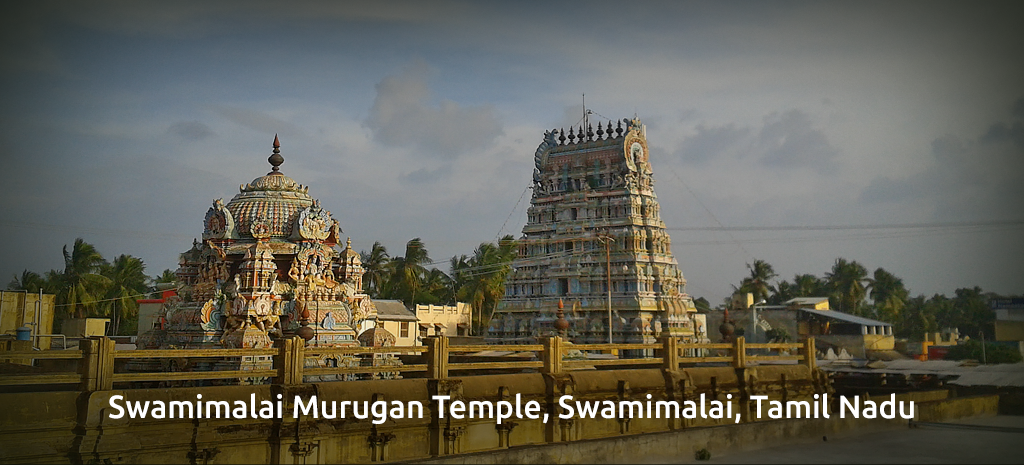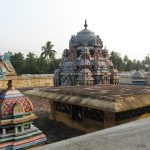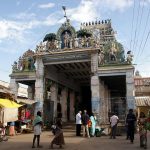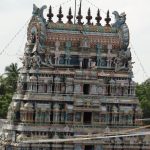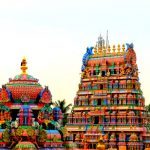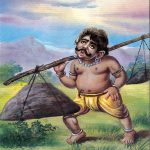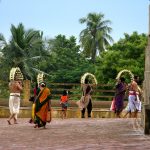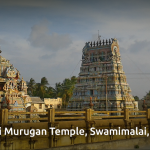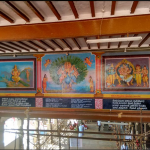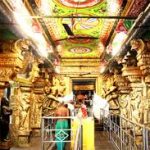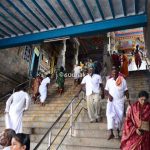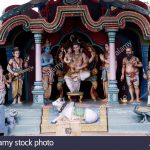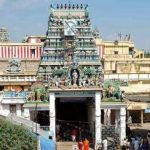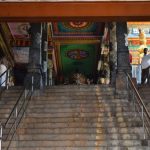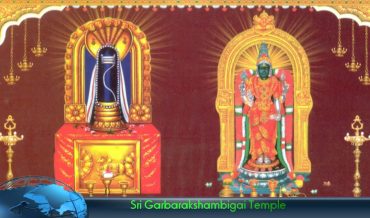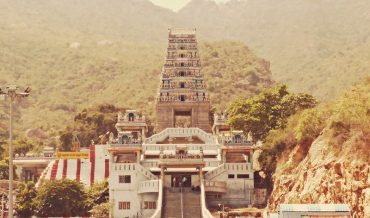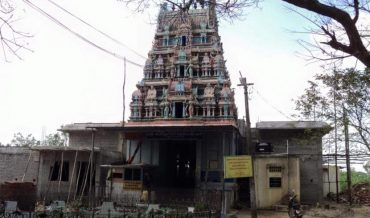
Swamimalai Temple
Main Deity: Bhagwan Murugan / Karthikeya / Kumara Swamy / Subrahmanya
Sthala Vriksha: Nelli Tree (Amla Tree)
Sthala Theertha:
Vajra Theertha, Kumara Theertha, Saravana Theertha, Netra Theertha.
Swamimalai Murugan Temple located in Swamimalai, 8 Kms from Kumbakonam on the banks of tributary of river Cauvery. The Temple is one of the Six Holy Shrines of Murugan called Arupadaiveedu in Tamil. The shrine of the presiding deity, Swaminathaswamy is located atop a 60 ft. hillock and the shrine of His mother Meenakshi (Parvathi) and father Shiva (Sundareswarar) is located downhill.
The Temple has three Gopurams, three precincts and 60 steps and each one named after the sixty Tamil years. These are considered at par with the importance of 18 steps in Sabarimalai. The deities of the Tamil years are praying to Bhagwan Murugan in the form of steps. Hence, the Padi Puja is conducted on Tamil and English New Year days with coconuts, fruits and singing hymns respectively.
This is the place where Bhagwan Murugan in childhood taught the meaning of mantra “OM” to His father Bhagwan Shiva. It is Bhagwan Murugan’s fourth home. There are no hills in Tanjore district. It is in this region, Swamimalai stands. As hills are the abodes of Bhagwan Karthikeya, He is gracing from this hill Temple.
Swamimalai is world famous for its school that teaches the ancient craft of making bronze icons.
Now we will see about Sattology of Mandir
Brahma, Bhagwan of creation, disrespected Muruga at the time of visiting Mount Kailash. The child Muruga got angry with Brahma and asked Him how he was creating living beings. Brahma said that he was creating living beings with the help of Vedas. On hearing the reply, Muruga asked Brahma to recite the texts from Vedas. Brahma started to recite the text with the
Holy word called Pranava Mantra, “OM”.
At that time Muruga stopped Brahma and asked Him to explain the meaning of the Pranava Mantra. Brahma could not reply and hence Muruga knocked Brahma on his forehead with his clenched fists and punished him with imprisonment.
Muruga took up the role of Brahma. The Devas were surprised by the absence of Brahma and they requested Bhagwan Vishnu to negotiate with Muruga to release Brahma. Vishnu could not help and as the last resort, Bhagwan Shiva went to the rescue of Brahma. Shiva came to Muruga and asked him to release Brahma from imprisonment. Muruga refused to release Him and stating Brahma was unaware of the meaning of Pranava Mantra (AUM). Shiva asked Muruga to explain the meaning and Muruga extolled to Shiva the meaning of the Pranava Mantra. Shiva behaved like a student to a teacher, listening with rapt attention from his son, giving Muruga the name “Swaminathan Swami”. The meaning of this name is “The Teacher of Shiva”. Following the Sattology, the shrine of the son Muruga is atop the hillock, while father Shiva’s shrine is present at the basement.
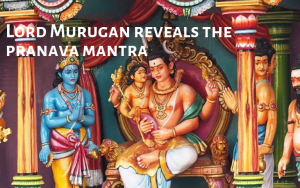
Murugan reveals the meaning of Pranava Mantra
Here we go with more Sattology Events about Bhagwan Subrahmanya and Bhrigu Maharishi
It is said that once, as a result of the curse laid on him by Bhrigu Maharishi, Bhagwan Shiva forgot the “Pranava Mantra“. He immediately sent for His son Subrahmanya and asked Him if he knew the Mantra. The young Subrahmanya smilingly replied that he does and he asked Bhagwan Shiva that if only the Bhagwan is prepared to learn the Mantra in a proper manner, then he would teach him. There upon with folded and learnt the Mantra. As this incident took place in this sacred place it came to be known as “Swamimalai” and the deity as Swaminathan, indicating that son was superior than His Father. This also the reason behind Bhagwan Subrahmanya is on hilltop while Bhagwan Shiva is present at the basement.
Meeting of Bhagwan Subrahmanya, Agasthya along with demon Idumba
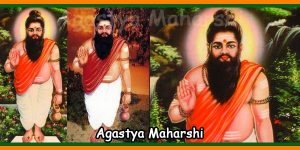
Agasthya Maharishi1
As per another Sattology, once all sages and Devas assembled in Kailash. It resulted in the tilting of earth towards one direction. Shiva asked Agastya Maharishi to move towards South to balance the tilt. Agastya employed a demon called Idumba to carry two hills on his shoulders to be placed in the south. The demon carried the hills down south and rested in a place. When he tried to lift one of the hills, it didn’t budge and he found a young man standing at the top of the hill not allowing it to be moved. The demon tried to attack the young man, but was smitten. Agastya Maharishi identified the young man as Karthikeya and asked him to pardon the demon. Karthikeya readily did so and let the hill remain there at Palani. It is a practice followed in the modern times where people carry milk in both their shoulders (popularly known as Kavadi and Paal Kudam in Tamil) as a devotion to please Karthikeya. The demon carried the other hill to Swamimalai.
History of Swamimalai Temple
The Temple of Swaminathan is very ancient one and it is known to have existed even in the 2nd Century BC. It is said that Parantaka Chola 1 built the Temple. The Temple was damaged to a great extent and the Gopurams were demolished and razed to ground in the year 1740 when the Anglo-French War was waged later when war broke out between Hyder Ali and the British. Swamimalai is fourth among the Six Padai Veedu or sacred shrines dedicated to Bhagwan Muruga. The presiding deity here expounded the meaning of the Pranava Mantra OM to His own Father Bhagwan Shiva himself.
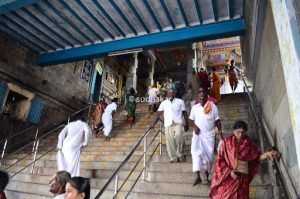
Temple Steps
Specialty of Temple
Bhagwan Muruga graces devotees in his best attire. He looks with a ripe, wise and philosophical look during the Vibhuti Abhishek, a majestic Bala Subrahmanya in Chandan Abhishek. If we observes closely the Sanctom Sanctorum, the Peetha on which Bhagwan stands looks like the Shiva Linga itself. This represents the philosophy that Bhagwan Shiv and Bhagwan Karthikeya are but one and not different from each other. In the place of the traditional peacock before the Bhagwan, there is an Airavatha (an elephant) here, which was gifted by Indira after the destruction of demon Harikesa according to scriptures.
Tamil word Muruga means all youthfulness and handsomeness. Needless to say that Bhagwan Muruga is handsomeness personified.
Swamimalai is the 4th Padaiveedu (army camp) of Bhagwan Muruga. 6 ft. tall Muruga graces with his tuft, Janeu on the chest and a staff in the right hand and the left on the lap. It is his Vel weapon that created the Nethra Theertha in the Temple. He graces in meditation style as a Guru. He graces with the Vajra Vel representing three divine powers – Itcha Shakthi, Gnana Shakthi, & Kriya Shakthi. Mother Earth worshiped Bhagwan Muruga for relief from a curse of Parvathi Matha and even after realizing Her boon, she is staying here in the form of a gooseberry tree.
Swamimalai Temple is praised in the hymns of Arunagirinathar Thirupugazh and in Tirumugattrupadai by Tamil poet Nakkeerar considered as the invocation song in Tamil literature edition. Brahma, Bhoomadevi, Indira worshiped Bhagwan Muruga in this Temple.
As the Bhagwan was a Guru to his own Father Bhagwan Shiva, the place is also known as Gurumalai or Gurugiri.
Architecture of Temple
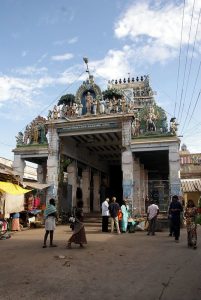
Main Entrance
In Swamimalai, Muruga is known as “Balamurugan” & “Swaminathan Swami“. The Temple has three Gopurams with three Praharams. The Gopuram on the south side of the Temple is decorated with moorthis and contains five storeys while the other two entrances have no towers above them.
The arrangement of the praharam is peculiar in this Temple. The 1st praharam is at the base of the hill, the 2nd halfway up the hill and the 3rd at the top surrounding the sanctom. Once you pass the “Raja Gopuram” and the “Kalyana Mandapam”, you reach the shrine dedicated to Maa Shakthi at the base. In addition to this there are other shrines for various other deities and the well with “Vajra Theertha”.
Steps leads towards the top of the hill, when you reach half way up the hill there is a small area where beautiful moorthis depicting the sattology associated with this temple have been created. Further above is the 2nd praharam. you climb further to reach the level where the shrine for Bhagwan Swaminathan is built. There are various shrines to other deities on the 1st Praharam.

Paintings
There are five Theerthams in and around the temple. They are:
Vajra Theertha, Saravana Theertha, Nethra Pushkarini (well), and Kumaratturai (Kaveri).
Sattology says it that once a blind devotee by name Sumathi lost his eyesight because of his Paapa Karmas. Bharadhwaja Maharishi asked him to go and worship Netra Vinayaga and take a dip in the Netra Theertham to get over his Papa Karmas and regain his sight. It is believed that the devotee regained his sight once he does what Maharishi advised Him to do.
Devotees does their respective Prayers to overcome with obstacles in their respective human life
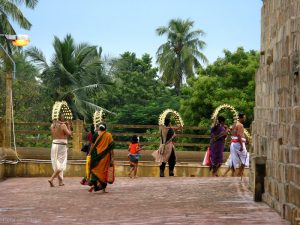
Kavadi
Bhagwan Muruga is the destination for solution of all problems in human life. People appeal to the Bhagwan for happy wedding life, child boon, family prosperity, longevity, education, wisdom, job opportunities, career growth in jobs and for removal of obstacles in their various endeavors.
Tonsuring, Abhishekam with Chandan, Panchamirtham (a mixture of five ingredients – Banana, dry fruits, jaggery, honey and ghee. For enhanced flavours few will add elaichi powder and edible camphor) and milk are performed by devotees. Carry milk pots (Paal Kudam in Tamil) and Kavadi and arrange poojas. Those facing enemy troubles perform Thirisada Archana. The rich offer liberal contributions for the maintenance and renovation of the temple.
How to reach this Temple – Location from Google maps – Click Here
Gallery:
- Gopuram View – Swamimalai Temple
- Main Entrance – Swamimalai Temple
- Main Gopuram – Swamimalai Temple
- View from Road – Swamimalai Temple
- Gopuram – Swamimalai Temple
- Idumban
- Main Entrance
- Struc-images on Gopuram
- Kavadi
- Main Gopuram
- Paintings
- Praharam
- 60 Steps indicating 60 names of Tamil Years
- stucco-figures-temple-swamimalai
- Swamimalai temple
- Swamimalai Temple Steps indicating 60 Tamil years names
- Murugan reveals the meaning of Pranava Mantra
Reference:
Temple Website: http://www.swaminathaswamytemple.tnhrce.in/
South India Temples Blog: https://tamilnadu-favtourism.blogspot.com/
Images Source: Google, Flickr, Sri. Arun Prasad & Sri. Satish
Here is the small video clip to have a better understanding about Swamimalai Temple
All information entered is personal to the author. Any modification or changes must be addressed to the author.

